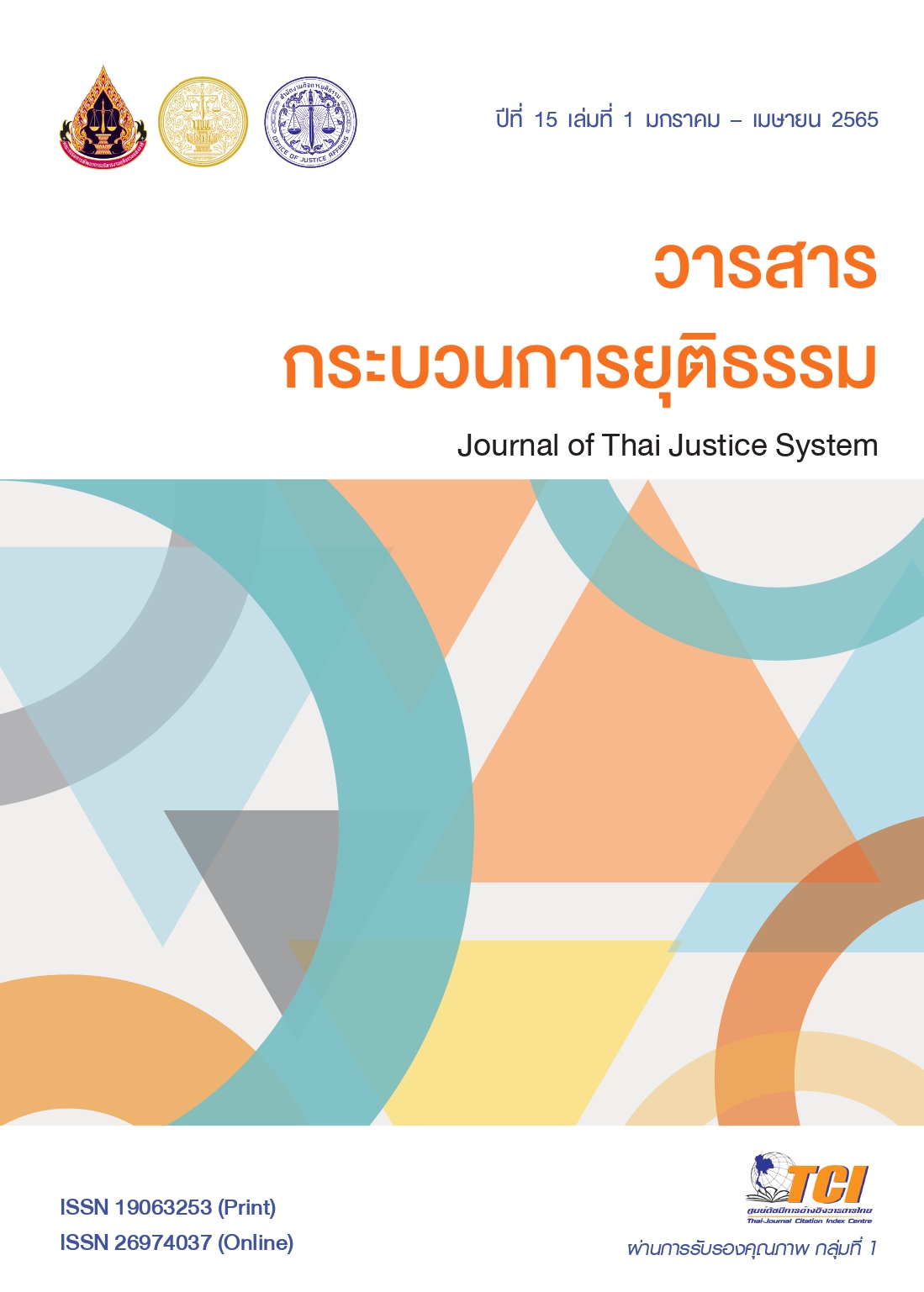แรงจูงใจที่ส่งผลต่อการกระทำผิดที่เกี่ยวข้องกับอาวุธปืน
Main Article Content
บทคัดย่อ
การศึกษาวิจัยครั้งนี้มีวัตถุประสงค์เพื่อศึกษาแรงจูงใจที่ส่งผลต่อการกระทำผิดที่เกี่ยวข้องกับอาวุธปืนและเสนอแนะแนวทางในการแก้ไขพฤติกรรมการกระทำผิด โดยใช้วิธีวิจัยเชิงคุณภาพด้วยวิธีการสัมภาษณ์เจาะลึกจากผู้ต้องขังที่อยู่ระหว่างต้องโทษ โดยใช้วิธีคัดเลือกแบบเจาะจงเฉพาะผู้กระทำผิดทุกรูปแบบที่เกี่ยวข้องกับอาวุธปืน ผลการวิจัยพบว่า แรงจูงใจที่ส่งผลต่อการกระทำผิดที่เกี่ยวข้องกับอาวุธปืนเกิดจาก การมีอารมณ์ร้อน โกรธง่าย โมโหรุนแรง ไม่สามารถควบคุมตนเองได้ประกอบกับผู้ต้องขังบางรายมีการดื่มแอลกอฮอล์ร่วม นอกจากนี้ ยังถูกกดดันจากสภาพแวดล้อม เช่น ถูกสามีทำร้าย มีปัญหาความรุนแรง ในครอบครัว ปัญหาทางเศรษฐกิจ โดยอาวุธที่ใช้ในการกระทำผิดส่วนใหญ่เป็นอาวุธปืนที่ไม่ได้รับอนุญาตหรือปืนเถื่อน ดังนั้นแนวทางในการแก้ไขควรเน้นไปที่ครอบครัว สถานศึกษา การปรับสภาพสังคมให้เป็นสังคมที่น่าอยู่ในทุก ๆ ด้าน อัตราการมีงานทำ รวมถึงการปรับปรุงกระบวนการยุติธรรมทางอาญาและกฎหมาย
Article Details

อนุญาตภายใต้เงื่อนไข Creative Commons Attribution-NonCommercial-NoDerivatives 4.0 International License.
ต้นฉบับที่ได้รับการตีพิมพ์ในวารสาร เป็นลิขสิทธิ์ของวารสารกระบวนการยุติธรรม แต่ความคิดเห็นที่ปรากฏในเนื้อหาของบทความในวารสารกระบวนการยุติธรรม ถือเป็นความรับผิดชอบของผู้เขียนแต่เพียงผู้เดียว
เอกสารอ้างอิง
ชาญคณิต กฤตยา สุริยะมณี. (2554). ทฤษฎีอาชญาวิทยาร่วมสมัยกับการวิจัยทางด้านอาชญาวิทยาในปัจจุบัน. กรุงเทพฯ: หยินหยาง.
ณัฐกร ลักษณชินดา. (2548). ปัจจัยที่มีอิทธิพลต่อการกระทำความผิดของผู้ต้องขังหญิงคดีความผิดต่อชีวิตในทัณฑสถานหญิงกลาง. วิทยานิพนธ์สังคมวิทยามหาบัณฑิต. จุฬาลงกรณ์มหาวิทยาลัย.
นพวัลภ์ คงคาลิหมีน, พัชราภรณ์ ชูสิงห์แค และปรางทิพย์ เอียดหมุน. (2559). การศึกษาพฤติกรรมการกระทำความผิด กรณีศึกษาเด็กและเยาวชนที่มารายงานตัวต่อศาลเยาวชนและครอบครัว จังหวัดสงขลา. ใน การประชุมหาดใหญ่วิชาการระดับชาติและนานาชาติครั้งที่ 7. มหาวิทยาลัยหาดใหญ่.
มูลนิธิอนุรักษ์โบราณสถานในพระราชวังเดิม กองบัญชาการกองทัพเรือ. (2564). อาวุธยิง. ค้นเมื่อ 17 สิงหาคม 2564, จาก http://www.wangdermpalace.org/weapon_th.html
พรชัย ขันตี, กฤษณพงค์ พูตระกูล และจอมเดช ตรีเมฆ. (2558). ทฤษฎีอาชญาวิทยา : หลักการ งานวิจัย และนโยบายประยุกต์. กรุงเทพฯ : มหาวิทยาลัยรังสิต.
วิชาญ น้อยโต. (2557). มาตรการทางกฎหมายในการควบคุมการมีและใช้อาวุธปืนตามกฎหมายอาวุธปืน เครื่องกระสุนปืน วัตถุระเบิดดอกไม้เพลิงและสิ่งเทียมอาวุธปืน. วิทยานิพนธ์นิติศาสตรมหาบัณฑิต. มหาวิทยาลัยธุรกิจบัณฑิต.
สุวรา แก้วนุ้ย และทักษพล ธรรมรังสี. (2554). พฤติกรรมการคุกคามทางเพศในกลุ่มเด็กและเยาวชนภายใต้อิทธิพลการบริโภคเครื่องดื่มแอลกอฮอล์. วารสารวิจัยระบบสาธารณสุข, 5(2), 233-243.
อภิวัฒน์ แก้วเพ็ง, มูฮัมหมัด อิลยาส หญ้าปรัง, ปรัชญา ชุ่มนาเสียว และสุชาติ ศรียารัณย์. (2560). สาเหตุการกระทำผิดซ้ำของผู้ต้องขัง กรณีศึกษาเรือนจำพิเศษมีนบุรี. การค้นคว้าอิสระรัฐศาสตรมหาบัณฑิต. มหาวิทยาลัยรามคำแหง.
อัณณพ ชูบำรุง และอุนิษา เลิศโตมรสกุล. (2555). อาชญากรรมและอาชญาวิทยา. กรุงเทพฯ: สำนักพิมพ์แห่งจุฬาลงกรณ์มหาวิทยาลัย
Asian Correspondent. (2016). Baffling statistics fail to hide Thailand’s worrying gun crime problem. Retrieved August 17, 2020, from https://asiancorrespondent .com/2016/02/thailand-gun-crime/
Cullen, F. T., & Robert, A. (2003). Criminological theory past to present. London: Roxbury.
Merton, R. K. (1957). Social theory and social structure (Rev. ed.). N.P.: Free Press.
Siegel, L. J. (2006). Criminology. CA: Thomsom Wardsworth.
Stuart, H. (1997). Representation, cultural representation and signifying practices. British: The British Printing.


